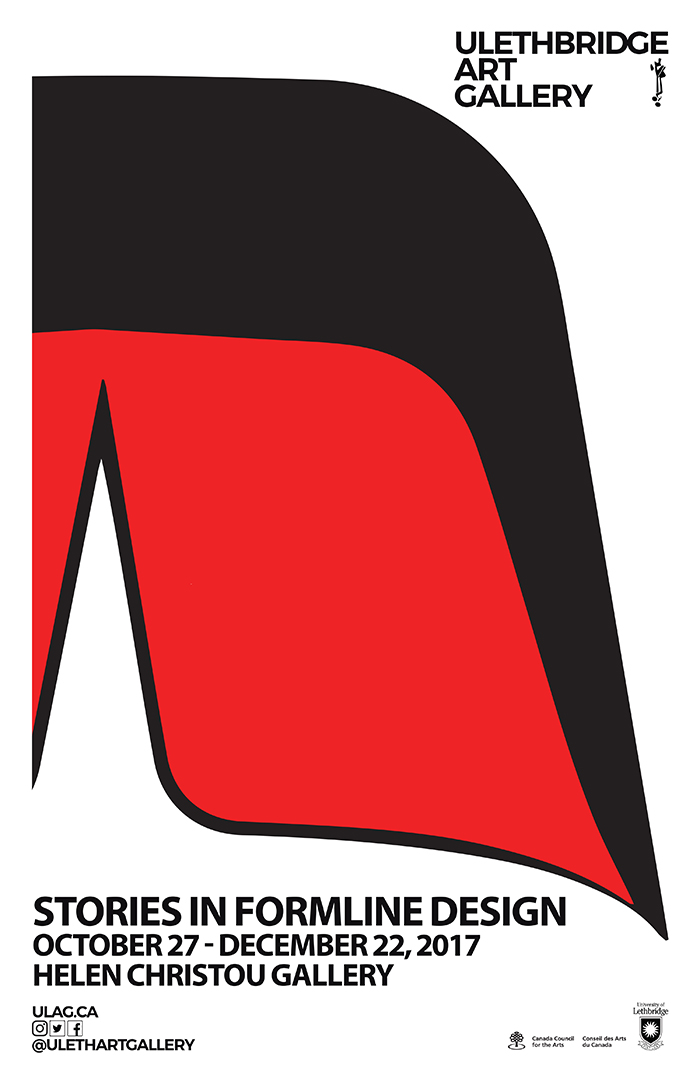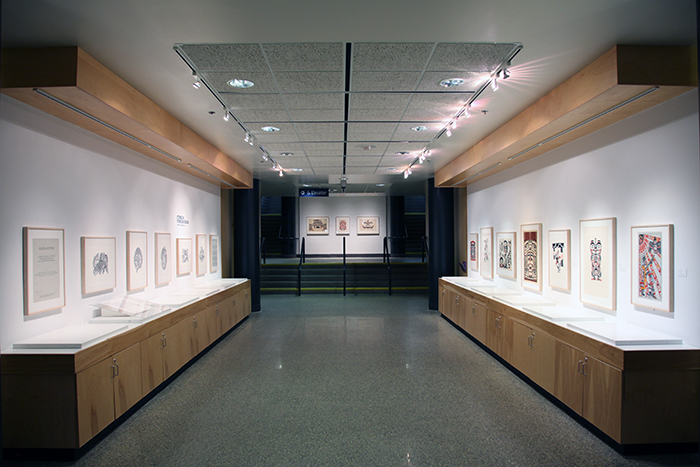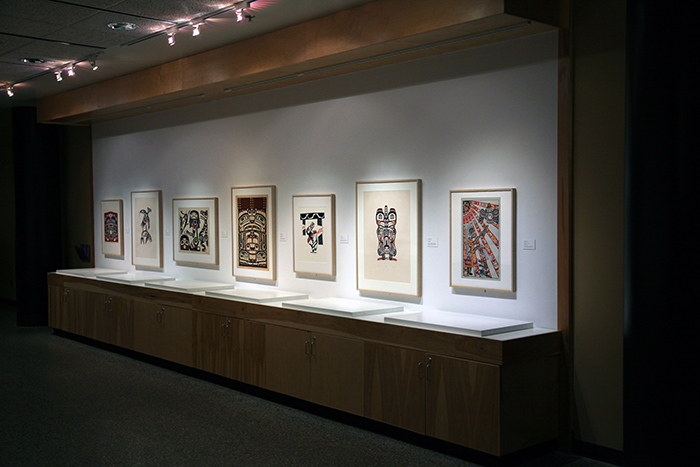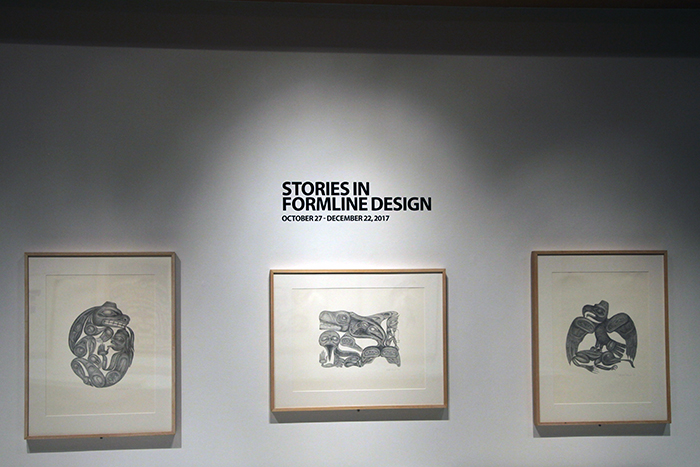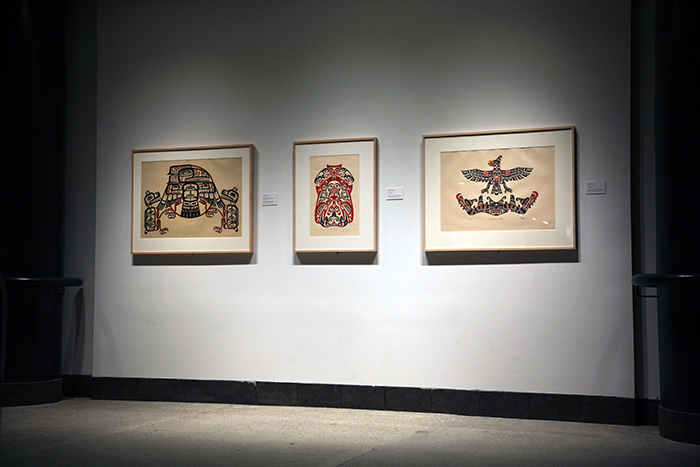Helen Christou Gallery
Stories in Formline Design
October 27 – December 22, 2017
Works from the University of Lethbridge Art Collection
Curated by David Smith
Selected from the art collection, this exhibition explores some of the stories shared through formline design techniques by First Nations artists of the northwest coast. Featuring Bill Reid, Tony Hunt, Stan Greene and others.
Curatorial Statement
Current archeological evidence supports the theory that Indigenous Peoples have inhabited the coast of what is now British Columbia for over 14,000 years. There is in fact a Heiltsuk village archeological site located on Triquet Island on B.C.’s Central Coast, which is older than the Roman Empire and three times older than the Great Pyramid at Giza.
Formline design, a term first coined by the historian Bill Holm in 1965, describes the design structure employed by the northern coastal tribes like the Haida and uses primarily ovoids, U forms and S forms. The Canadian Museum of History has a Tsimshian comb in their collection, from the Skeena River region, which is considered one of the first known examples of formline design and dates between c. 800 – 1200 CE.
The sophisticated design scheme that is formline design predates the Western contact which brought massive population loss resulting from the spread of European diseases to the Indigenous Peoples of the Northwest Coast. The potlatch ceremony was a highly regulated and elaborate gift giving ritual used by costal Indigenous Peoples to celebrate births, marriages and funerals. Canadian legislation banning the practice of the potlatch in 1885 lasted until 1951 and had a profoundly negative impact on the social welfare of the Indigenous Peoples as well as their production of cultural objects. The Canadian Indian residential school system, which orchestrated the involuntary removal of over 150,000 Indigenous children nation-wide from their families between 1883 – 1996, also aimed to sever the connection between generations of Indigenous Peoples and their families, languages, beliefs and ways of life.
Despite incredible obstacles, the Indigenous Peoples of the Northwest Coast have demonstrated remarkable resilience. Though art production never completely ceased, in the 1950s there was a major revival of art from the Northwest Coast. On a trip to Haida Gwaii in 1954, Bill Reid was inspired by the work of his great-great uncle Charles Edenshaw. He spent the rest of his life researching, learning and creating works in formline design. Though he was not conscious of his own Haida heritage until he was a teenager, Bill Reid was instrumental in the revival of Northwest Coast art. The portfolio of prints by Reid included in this exhibition are an exciting recent addition to the University of Lethbridge Art Gallery collection and were donated by the late Jim Coutts in 2013.
The production of Northwest Coast prints really took off after printmaking entered the mainstream in the 1960s when Pop artists like Andy Warhol helped foster an appreciation of silkscreen prints as high art. One of the distinctive features of Northwest Coast prints is the use of storytelling that often accompanies them.[1] This capacity to tell a story, to share a culture, has perpetuated printmaking as an Indigenous mode and allowed it to maintain a place between tradition and innovation.[2] The idea of “the story” is often a conflicted one for the modern art curator. Where, in the modern art world, the artist is being divested of the larger responsibilities to make meaning or to unite society, the Indigenous artist is tasked with feeding a family by maintaining a culture.[3] Many contemporary artists of the Northwest Coast continue to make art inspired by formline design and storytelling.
– David Smith, Assistant Curator / Preparator
[1] Linda Tuhiwai Smith, Decolonizing Methodologies (New York: St Martin’ s Press, 1999), 144.
[2] Leslie Dawn, The Northwest Coast Native Print: A Contemporary Tradition Comes of Age (Victoria: Art Gallery of Great Victoria, 1985), 7.
[3] India Young, “Re-pressed: How Serigraphy Re-envisions Northwest Coast Iconography” ARTiculate 1, no. 1 (September 2012): 42.
